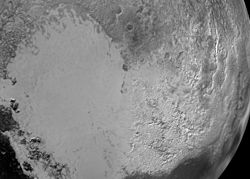 A detailed view of Tombaugh Regio; a constructed mosaic of monochrome images by New Horizons. | |
| Feature type | Region |
|---|---|
| Location | Anti-Charon hemisphere of Pluto |
| Diameter | 1,590 km (990 mi)[1] |
| Discoverer | New Horizons |
| Eponym | Clyde Tombaugh |
Tombaugh Regio (/ˈtɒmbaʊ ˈrɛdʒioʊ/), sometimes nicknamed "Pluto's heart" after its shape,[2] is the largest bright surface feature of the dwarf planet Pluto.[3][4][5] It lies just north of Pluto's equator, to the northeast of Belton Regio and to the northwest of Safronov Regio, which are both dark features.[6] Its western lobe, a 1,000 km (620 mi)-wide plain of nitrogen and other ices lying within a basin, is named Sputnik Planitia.[7][8] The eastern lobe consists of high-albedo uplands thought to be coated by nitrogen transported through the atmosphere from Sputnik Planitia, and then deposited as ice. Some of this nitrogen ice then returns to Sputnik Planitia via glacial flow. The region is named after Clyde Tombaugh, the discoverer of Pluto.
- ^ Cite error: The named reference
whalewas invoked but never defined (see the help page). - ^ New Horizons spacecraft displays Pluto's big heart Archived 16 July 2015 at the Wayback Machine. NASA.gov. 14 July 2015. Retrieved 15 July 2015.
- ^ O'Kane, Sean (15 July 2015). "This is the first high resolution image of Pluto's surface". The Verge. Archived from the original on 5 January 2019. Retrieved 15 July 2015.
- ^ Coldewey, Devin (15 July 2015). "Latest New Horizons Photo Shows Close-Up of Pluto's Young Mountains". NBC News. Comcast. Archived from the original on 17 August 2019. Retrieved 15 July 2015.
- ^ The New York Times (15 July 2015). "New Horizons Reveals Ice Mountains on Pluto". The New York Times. Archived from the original on 7 February 2019. Retrieved 15 July 2015.
- ^ McKinnon, Mika (14 July 2015). "Places on Pluto are Being Named for Your Darkest Imaginings". Archived from the original on 22 July 2015. Retrieved 23 July 2015.
- ^ "New Horizons Discovers Flowing Ices on Pluto". NASA. 24 July 2015. Archived from the original on 17 March 2016. Retrieved 25 July 2015.
- ^ Lakdawalla, Emily (21 December 2015). "Pluto updates from AGU and DPS: Pretty pictures from a confusing world". The Planetary Society. Archived from the original on 24 December 2015. Retrieved 24 January 2016.